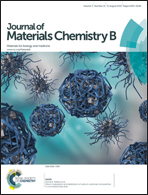Incorporation of quantum dots into silk biomaterials for fluorescence imaging†
Abstract
Tracking the distribution and degradation of biomaterials after in vivo implantation or injection is important for tissue engineering and drug delivery. Intrinsic and externally labeled fluorescence has been widely used for these purposes. In the present study, 3-mercaptopropionic acid (MPA)-coated CdTe quantum dots (QDs) were incorporated into silk materials via strong interactions between QDs and silk, likely involving the hydrophobic beta-sheet structures in silk. MPA-QDs were pre-mixed with silk solution, followed by ultrasonication to induce silk gelation or by blending with polyvinyl alcohol (PVA) to generate silk microspheres. Silk structural changes and hydrogel/microsphere morphologies were examined by ATR-FTIR and SEM, respectively. The fluorescence of QD-incorporated silk hydrogels and microspheres remained stable in PBS pH 7.4 for more than 4 days. The amount of QDs released from the materials during the incubation was dependent on loading; no QDs were released when loading was below 0.026 nmol mg−1 of silk. After subcutaneous injection into mice, the fluorescence of QD-incorporated silk microspheres was quenched within 24 h, similar to that of free QDs. In contrast, the QD-incorporated silk hydrogels fluoresced for more than 4 days in vivo.


 Please wait while we load your content...
Please wait while we load your content...